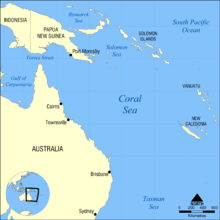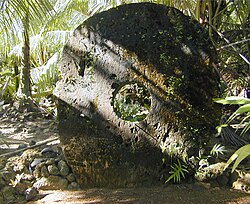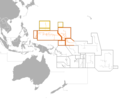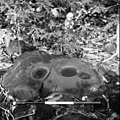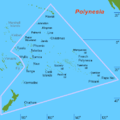An orthographic projection of Oceania
Oceania OH -s(h)ee-AH -nee-ə, -AY -OH -shee-A(H)N -ee-əgeographical region including Australasia , Melanesia , Micronesia , and Polynesia . Outside of the English-speaking world, Oceania is generally considered a continent , while Australia is regarded as an island or a continental landmass within that continent. Spanning the Eastern and Western Hemispheres , at the centre of the water hemisphere , Oceania is estimated to have a land area of about 9,000,000 square kilometres (3,500,000 sq mi) and a population of around 44.4 million as of 2022. Oceania is the smallest continent in land area and the second-least populated after Antarctica .
Oceania has a diverse mix of economies from the highly developed and globally competitive financial markets of Australia , French Polynesia , Hawaii , New Caledonia , and New Zealand , which rank high in quality of life and Human Development Index , to the much less developed economies of Kiribati , Papua New Guinea , Tuvalu , Vanuatu , and Western New Guinea . The largest and most populous country in Oceania is Australia, and the largest city is Sydney . Puncak Jaya in Indonesia is the highest peak in Oceania at 4,884 m (16,024 ft).
The rock art of Aboriginal Australians is the longest continuously practiced artistic tradition in the world. Most Oceanian countries are parliamentary democracies , with tourism being a large source of income for the Pacific island nations . (Full article...
The Coral Sea Mer de Corail ) is a marginal sea of the South Pacific off the northeast coast of Australia, and classified as an interim Australian bioregion . The Coral Sea extends 2,000 kilometres (1,200 mi) down the Australian northeast coast. Most of it is protected by the French Natural Park of the Coral Sea (French : Parc Naturel de la Mer de Corail ) and the Australian Coral Sea Marine Park . The sea was the location for the Battle of the Coral Sea , a major confrontation during World War II between the navies of the Empire of Japan , and the United States and Australia.
The sea contains numerous islands and reefs , as well as the world's largest reef system, the Great Barrier Reef (GBR), which was declared a World Heritage Site by UNESCO in 1981. All previous oil exploration projects were terminated at the GBR in 1975, and fishing is restricted in many areas. The reefs and islands of the Coral Sea are particularly rich in birds and aquatic life and are a popular tourist destination, both domestically and internationally. (Full article...
A large (approximately 8 feet (2.4 m) in height) example of Yapese stone (Rai) in the village of Gachpar A rai stone Yapese : raay ), or fei stone , is one of many large artifacts that were manufactured and treasured by the native inhabitants of the Yap islands in Micronesia . They are also known as Yapese stone money or similar names.
The typical rai stone is carved out of crystalline limestone and shaped like a disk with a hole in the center. The smallest may be 3.5 centimetres (1.4 in) in diameter. The largest extant stone is located on Rumung island, near the Riy village; it is 3.6 metres (12 ft) in diameter and 50 centimetres (20 in) thick, and weighs 4,000 kilograms (8,800 lb). (Full article...
The following are images from various Oceania-related articles on Wikipedia.
Image 1 Map showing the migration and expansion of the
Austronesians which began at about 3000 BC from
Taiwan . The Polynesian branch is shown in green. (from
Polynesia )
Image 3 Polynesians with
outrigger canoes at
Waikiki Beach ,
Oahu Island , early 20th century (from
Polynesia )
Image 5 Moai at Ahu Tongariki on
Rapa Nui (from
Polynesia )
Image 6 Polynesian (Hawaiian) navigators sailing multi-hulled
canoe , c. 1781 (from
Polynesia )
Image 8 German New Guinea before and after the German-Spanish treaty of 1899 (from
Micronesia )
Image 9 Australia's concept of Australasia, which includes Australia, New Zealand and, in this case,
Melanesia (from
Australasia )
Image 10 Outline of sovereign (dark orange) and dependent islands (bright orange) (from
Micronesia )
Image 11 German trading station at
Jaluit Atoll with a Marshallese
korkor outrigger canoe in the foreground (from
Micronesia )
Image 12 Polynesia is one of three major cultural areas of the
Pacific Ocean islands , along with
Melanesia and
Micronesia . (from
Polynesia )
Image 13 The Polynesian spread of colonization in the Pacific (from
Polynesia )
Image 14 Grinding stones discovered from
archaeology in Samoa (from
Polynesia )
Image 15 Aerial view of
Solomon Islands (from
Melanesia )
Image 17 Mokoliʻi Isle near
Oahu ,
Hawaii (from
Polynesia )
Image 18 Canoe carving on
Nanumea atoll, Tuvalu (from
Polynesia )
Image 19 Chronological dispersal of
Austronesian peoples across the
Indo-Pacific (from
Micronesia )
Image 21 The arrival of
Abel Tasman in
Tongatapu , 1643; drawing by
Isaack Gilsemans (from
Polynesia )
Image 22 Painting of
Tahitian Women on the Beach by
Paul Gauguin —
Musée d'Orsay (from
Polynesia )
Image 23 Micronesia is one of three major cultural areas of the
Pacific Ocean islands , along with
Melanesia and
Polynesia . (from
Micronesia )
Image 24 Cook's Bay on
Moorea ,
French Polynesia (from
Polynesia )
Image 26 Māori
war canoe drawn after
James Cook 's voyage to New Zealand. (from
Polynesia )
Image 27 Melanesia is one of three major cultural areas of the
Pacific Ocean islands , along with
Micronesia and
Polynesia . (from
Melanesia )
Image 28 Subregions (
Melanesia ,
Micronesia , Polynesia, and
Australasia ), as well as sovereign and dependent islands of
Oceania (from
Polynesia )
Image 29 Beach scenery at
Laura ,
Majuro , Marshall Islands (from
Micronesia )
Image 30 Polynesia is generally defined as the islands within the
Polynesian Triangle . (from
Polynesia )
Image 31 Cinder plain of
Mount Yasur in
Vanuatu (from
Melanesia )
Image 32 Sailors of Melanesia in the
Pacific Ocean , 1846 (from
Melanesia )
Image 33 Outline of sovereign (dark orange) and dependent islands (bright orange) (from
Melanesia )
Image 34 On February 14, 1779, Capt.
James Cook was killed on the island of Hawaii (from
Polynesia )
Image 35 Kili Island is one of the smallest islands in the
Marshall Islands . (from
Micronesia )
Image 36 Image of the
Castle Bravo nuclear test, detonated on 1 March 1954, at
Bikini Atoll (from
Micronesia )
Image 38 A
Melanesian child from
Vanuatu (from
Melanesia )
Image 39 A pan flute from
Solomon Islands , 19th century (from
Melanesia )
Image 40 Mount Marpi in
Saipan . (from
Micronesia )
Image 41 Chronological dispersal of
Austronesian peoples across the
Indo-Pacific (from
Melanesia )
Image 42 An illustration of the Cross Spikes Club of the US Navy on
Bikini Atoll , one of several Marshall Islands used for
atomic bomb tests . (from
Micronesia )
Image 43 Subregions (
Melanesia ,
Micronesia ,
Polynesia and
Australasia ), as well as sovereign and dependent islands of
Oceania (from
Micronesia )
Image 44 King
Kamehameha I receiving the Russian naval expedition of
Otto von Kotzebue . Drawing by
Louis Choris in 1816. (from
Polynesia )
Image 45 Languages of Micronesia. (from
Micronesia )
Image 46 A common fishing canoe
va'a with outrigger in
Savaiʻi island,
Samoa , 2009 (from
Polynesia )
Image 47 Chamorro people in 1915 (from
Micronesia )
Image 48 Carving from the ridgepole of a
Māori house, ca 1840 (from
Polynesia )
Image 49 Map of Melanesia, showing its location within Oceania (from
Melanesia )
Image 50 A depiction of a royal
heiau (Hawaiian temple) at
Kealakekua Bay , c. 1816 (from
Polynesia )
Image 51 Outline of sovereign (dark orange) and dependent islands (bright orange) (from
Polynesia )
Australasia Melanesia Micronesia Polynesia
Adamstown Pitcairn Islands 6 Alofi Niue 7 Apia Samoa Avarua Cook Islands 7 Fakaofo Tokelau 8 Funafuti Tuvalu Mata Utu Wallis and Futuna 2 Nukuʻalofa Tonga Pago Pago American Samoa 4 Papeete French Polynesia 2
Category puzzle Select [►] to view subcategories
Here are some tasks awaiting attention:
Wikipedia in other languages used in Oceania:
Purge server cache
